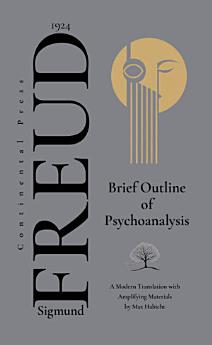Brief Outline of Psychoanalysis
may 2024 · The Collected Complete Works of Sigmund Freud Libro 3 · Continental Press
Libro electrónico
50
Páginas
family_home
Apto
info
reportLas calificaciones y opiniones no están verificadas. Más información
Acerca de este libro electrónico
Kurzer Abriss der Psychoanalyse (Brief Outline of Psychoanalysis), published in 1924, is one of Freud's most deliberate attempts to present psychoanalytic theory in a clear, systematic form accessible to both medical professionals and educated laypeople. Originally written at the request of the Encyclopaedia Britannica, this concise work distills nearly three decades of psychoanalytic development into its essential elements. The text arrives at a crucial moment in Freud's career, after his introduction of the structural theory of id, ego, and superego, allowing him to present both his classical and newer theoretical innovations in a unified framework. It demonstrates Freud's remarkable ability to compress complex ideas without sacrificing their fundamental importance. The work achieved particular significance in the English-speaking world, where it served as a primary introduction to psychoanalytic thought for many readers. Unlike his more specialized or theoretical works, this text was deliberately crafted to be accessible while maintaining scientific rigor. Its influence extended beyond individual therapy into broader fields of education, social work, and general medicine. The work's enduring value lies in its clarity and comprehensiveness, managing to cover topics from the unconscious and dreams to therapeutic technique and cultural applications of psychoanalysis in a remarkably concise format. Modern readers continue to find it one of the most useful entry points into Freudian thought, particularly for its systematic presentation of psychoanalytic principles. This edition includes an introduction by the translator on the philosophic differences between Carl Jung and Sigmund Freud, a glossary of Freudian Psychological terminology and a timeline of Freud’s life & works. This fresh, modern translation from the original German manuscript breathes new life into this historically important work. Freud's massive body of work has historically been inaccessible to the lay philosopher, and this edition seeks to provide greater, direct access to his original works. This new Reader's Edition introduces Freud's original work in context, with an illuminating Afterword explaining his philosophic project, nesting it in the historical milieu he wrote within (in this case, Modernism), and his impact on the contemporary world. This Afterword focuses on the relationship and debate between Carl Jung and Sigmund Freud, a conflict which has great relevance to the debates of modern culture. This is accompanied by a timeline of his life and works, an index of philosophic terminology and background (especially on his greatest influence- Schopenhauer), and a short biography.
Acerca del autor
Sigmund Freud (1856-1939) was an Austrian neurologist and the founder of psychoanalysis, a groundbreaking approach to understanding the human psyche. Freud introduced concepts such as the unconscious mind, repression, and the tripartite structure of the psyche, which includes the id, ego, and superego. His work, including seminal texts like The Interpretation of Dreams and Beyond the Pleasure Principle, emphasized the role of unconscious drives and childhood experiences in shaping behavior and personality. Freuds theories on sexuality, defense mechanisms, and dream analysis challenged societal norms and profoundly altered the field of psychology, influencing literature, art, and philosophy. Though controversial, his contributions laid the foundation for modern psychotherapy and continue to spark debates and inspire new approaches to understanding human behavior and mental processes.
Califica este libro electrónico
Cuéntanos lo que piensas.
Información de lectura
Smartphones y tablets
Instala la app de Google Play Libros para Android y iPad/iPhone. Como se sincroniza de manera automática con tu cuenta, te permite leer en línea o sin conexión en cualquier lugar.
Laptops y computadoras
Para escuchar audiolibros adquiridos en Google Play, usa el navegador web de tu computadora.
Lectores electrónicos y otros dispositivos
Para leer en dispositivos de tinta electrónica, como los lectores de libros electrónicos Kobo, deberás descargar un archivo y transferirlo a tu dispositivo. Sigue las instrucciones detalladas que aparecen en el Centro de ayuda para transferir los archivos a lectores de libros electrónicos compatibles.











